In Greek there is the word "scolios", which translates as "crooked".With this word, doctors denote the curvature of the spine from the spine.Also, not all curvature, namely, the lateral deviation of the vertical axis of the spine.The fact is that our column is usually not perfectly uniform.Curves available on the front and back (lordosis and kyphosis) protect our column from excessive loads, keeping the body in a certain position when moving and carrying weights.Negative processes in our body develop only in cases where these kifoses and lordosis are expressed in excess of the allowed norm.
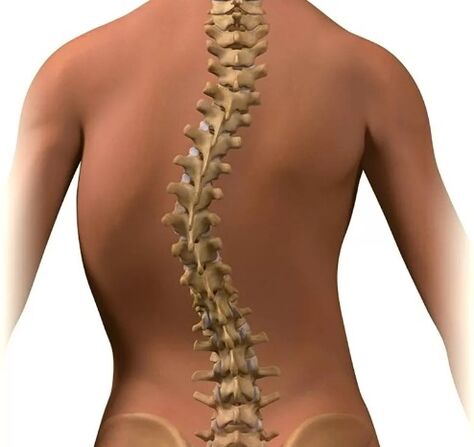
The main problems
However, even a small degree of sideline (scoliosis) of the spine is always a pathology.And the point is not just in a cosmetic defect.Although a characteristic repulsive appearance with pronounced or progressive scoliosis is always a tragedy for a person seeking to live a complete high quality life.This is especially true for boys and girls.In fact, it is in the child and youthful period (up to 15 to 16 years) that a significant part of scoliosis is diagnosed.
The main problem is that, due to a change in the configuration and volume of the pronounced lateral curvature, the internal organs always suffer (heart, lungs, stomach, liver, intestines, large vessels).In men, tolerance to physical effort decreases, women have problems with conception, with pregnancy and pregnancy.In addition, the lateral deformation of the spine is often just the surface of the iceberg, which is a sign of a much more severe pathology - tumor, tuberculosis, endocrine disorders.
Reasons
So why is the column deformed?Before answering the question, you should decide on the types of scoliosis.In essence, scoliosis can be structural and not structural.Structural scoliosis develops due to anatomical changes in the structure of the bone tissue of the vertebrae, as well as the muscles, nerves and ligament appliances located nearby.Such curvatures can be acquired and congenital, and about a quarter of all diagnosed scoliosis is responsible for the latter.
Among the main reasons for the development of structural scoliosis, they distinguish:
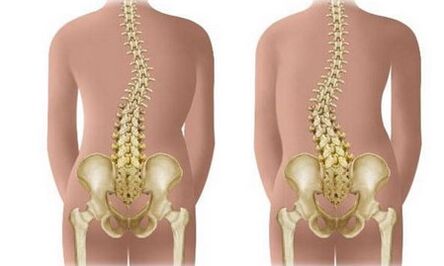
- Intrauterine development masts, leading to dysplastic disorders of one or more vertebrae
- Congenital breast development abnormalities - lack of ribs, additional ribs
- Congenital connective tissue pathology - neurofibromatosis, marfan syndrome
- Brain insufficiency due to children's cerebral palsy (cerebral palsy), leading to a violation of innervation of certain parts of the spine
- Osteoporosis (bone attempted)
- Vertebrae osteomyelitis
- Dystrophic changes in the cervical, thoracic and lumbar muscles
- Tuberculosis damage to vertebrae
- Spine lesions
- Spine tumors.
Non -structural scoliosis, as it follows its name, are the side deviations of the spine axis of the spine with the unchanged structure of the vertebrae.As a rule, this scoliosis is most often acquired, except for cases where the curvature is compensatory in congenital anatomical defects in the pelvis or lower ends.The causes of this scoliosis are more often:
- Pelvic lesions and lower ends
- Congenital defects in the pelvis and lower ends
- Constant inadequate posture in school -age children
- Internal organs with asymmetrically expressed pain syndrome
- Muscle inflammation (myiosites)
- Burns, scars of soft tissues on one side.
In these cases, to eliminate the curvature of the spine, it is sufficient to cure the underlying disease and therefore many non -structural scoliosis are easily reversible.In this sense, some doctors tend not to consider non -structural deformations to scoliosis in general.
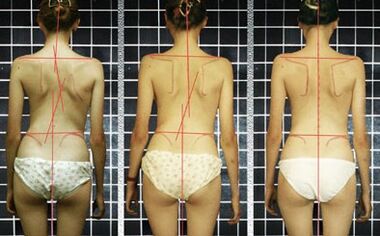
Recently, cases of scoliosis development with unclear causes have become more frequent.This is so -called idiopathic scoliosis.It occurs in youth years during the rapid growth of the body.In addition, girls suffer from idiopathic scoliosis several times more often than young people.Apparently, this is due to the relatively weak muscles of the back of the female, which is not able to include the spine in a complete muscle structure.An unbalanced diet with low calcium salts and a general passion for young people with carbonated beverages plays one last role in the development of idiopathic scoliosis.As you know, carbon dioxide in bubbles and orthophosphoric acid in synthetic inclusions contribute to the leaching of calcium salts in the body.
Varieties and Degrees
Depending on the location, scoliosis may be cervical, chest, lumbar or mixed (cervical, lumboscro).It is possible to have one or more arches of curvature.In this sense, the C -shaped scoliosis (with 1 arc), in the form of S (with 2 arches) and in the form of Z (with 3 arches) are distinguished.Probably the presence of 2 or 3 ARCs is compensatory.With C -shaped scoliosis, the spine column shaft deviates.In an effort to compensate for this, the column folds in the opposite direction.In this sense, scoliosis is divided into offset and unlipped.In the curvature of the plywood spine, a low -7th vertebra vertical line is wrapped around the buttocks.
The column curvature is often combined.For example, in the thoracic region, in addition to the lateral curvature, pathological kyphosis is observed, or simply a hunchback.In such cases, speaking of thoracic kyphoscoliosis.In addition, with large degrees of scoliosis, in addition to the lateral displacement of the vertebrae, Thuria is observed.In a literal translation, that means cheering.In fact, with many scoliosis, the vertebral bone tissue is twisted along the vertical axis.
Depending on the size of the curvature arc angle, 4 degrees of scoliosis are distinguished:
- 1 degree- The angle of curvature does not exceed 10 degrees.The asymmetry by eye is not practically determined.The inclination, the unequal level of the shoulder waist, pays attention.
- 2 degree- The curvature angle is 11 to 25 degrees.In this extension, the vertebrae are already observed.There is an asymmetry of the shoulder waist and pelvis that is visible in the eyes.Due to pathological muscle tension, a muscle roll is formed in the lumbar region of the concave side and in the chest area a convex.
- 3 degrees- Wrtification is 26 to 50 degrees.Visible thorax deformation - the west of intercostal spaces C on the concave side of the curvature and convex bulging.Weakening of the abdominal press, the formation of an internal hump.
- 4 degrees- The angle of curvature I exceed 50 degrees.A cosmetic defect and all previous signals are expressed.Low tolerability of a small physical effort.In addition to the musculoskeletal system, the internal organs suffer.
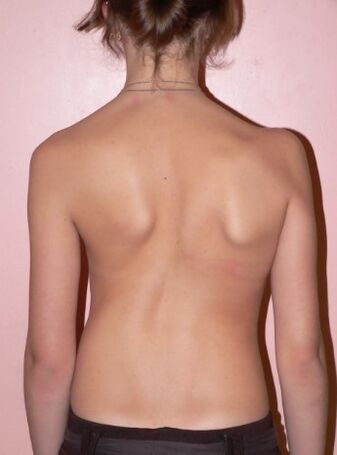
The angle may vary depending on the position of the body, while stable and unstable scoliosis is distinguished.With unstable scoliosis, it decreases in the lying position when the load in the spine column decreases.With a stable curvature of the spine, this value remains unchanged.
Symptoms
Recently, orthopedists usually use the term "scoliotic disease."And indicate a complex of negative changes that occur in the body during the curvature of the spine.As a rule, scoliotic disease develops in childhood and adolescence during the formation of the musculoskeletal system.At this time, there is a high probability that the progressed scoliosis.
Apparently intervertebral discs play an important role in increasing the angle of curvature.With a side displacement, the disc experiences unequal pressure from vertebral bodies.On the concave side, this pressure is higher, with a convex - less.As a result, the disc is further wear out of scoliosis, a pathological muscle tension (muscle roll) is created and the twisting of the vertebrae - all leads to the appearance of herniates and an additional increase in the curvature angle.
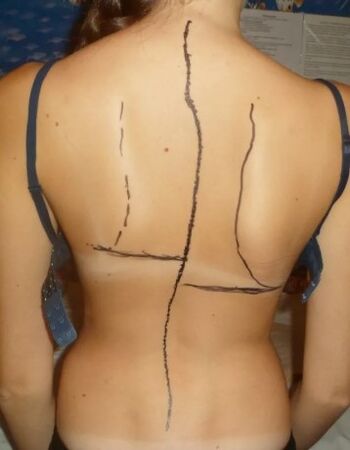
Together with the spine with a scoliotic disease, the chest changes second.The hunchback of the rib so that it is formed - on the convex side of the curvature, the intercostal spaces expand and, from the concave - on the contrary, they are sown.With 4th degree scoliosis, chest deformation is so pronounced that the lower ribs on the side of the curvature are in contact with the iliac bone row.
Due to severe chest deformation, a complete excursion during breathing is difficult.As a result, the body with severe scoliosis does not receive the necessary amount of oxygen - chronic hypoxia called so develops with a violation of all metabolic processes in the body.The pathology is aggravated by the fact that the internal volume and form of the chest cavity change.For this reason, blood circulation through the vessels is disturbed, the lungs suffer, the shape of the heart changes and chronic cardiovascular failure develops.
Similar changes occur in the abdominal organs for lumbar and lumbosacra scoliosis.Stomach and intestine engines are reduced with subsequent enzymatic insufficiency of the digestive glands.All this exacerbates only metabolic disorders.These violations usually lead to late sexual maturation of boys and girls.Also, due to lumbar scoliosis, the pelvis is curved for the second time.This creates problems for future mothers with pregnancy and pregnancy.
Diagnosis
The diagnosis of scoliosis, especially large degrees, is not difficult.To detect the deformation of the spine, a common visual examination is sufficient.The visible curvature of the vertebral spine contours, the asymmetry of the shoulder waist, the omplate angles, the secondary curvature of the pelvis and the lower limb shortening on the side of the curvature are noteworthy.
In the presence of at least one of these signs, the spinal spine radiography is indicated.X -ray determines the configuration, degree and location of the curvature.During inspection and radiological examination, it is possible to establish whether scoliosis is compensated and stable.Recently, a qualitatively new method of magnetic resonance research in the spine (RM) has been spread during which a three -dimensional image of the spine can be obtained on the monitor screen.With significant curvatures, it is necessary to investigate the work of internal organs - perform a spirometry, electrocardiography and perform an ultrasound of the heart and internal organs.
Treatment
Scoliosis treatment can be performed conservatively and promptly.Conservative methods include drug treatment, massage, physiotherapeutic procedures and manual therapy.It should be borne in mind that the final formation of the column purposes at the age of 20 and, after this age, the correction of curvature is almost impossible.With 1-2 degrees scoliosis, efforts aim to reach the normal and normal column configuration.With the pronounced scoliosis of the 3rd - 4th degree, this is unattainable, the main one here is to stabilize the spine and prevent the progression of scoliosis.

Medicines (chondroprotectors, vitamins, general strengthening medications) in the treatment of scoliosis play only an auxiliary role.To strengthen the muscles, eliminate the muscle roll and even largely to stabilize the spine with the help of massage and manual therapy.A good effect is given by physical therapy exercises.But here, with inappropriate physical effort, the instability of the spine is improved and scoliosis progresses.Therefore, a set of exercises is developed for each patient individually, taking into account the location and severity of the curvature.With a great degree of scoliosis, running, strength exercises, jumps, outdoor games are against -Indicated.
A very good result provides correction by position - the ideal pose is created that contributes to the standardization of posture.For this, special devices, orthopedic cribs are used in which young patients spend a significant part of time.With the ineffectiveness of conservative measures, it is indicated the progression of curvature, the surgical treatment designed to stabilize the spine.Surgical correction is not shown in early childhood, it is performed in adolescence, when spine formation is almost completed.

















































